Visualize walking down the bustling streets of Vienna in 1913, brushing shoulders with the likes of Trotsky, Tito, and perhaps even a young Hitler. This isn’t a scene from a historical novel; it’s a glimpse into a year where the paths of future world leaders converged in one city, setting the stage for a century that would reshape our world.

1913 Vienna wasn’t just another European capital; it was a melting pot of ideas, ambitions, and personalities that would go on to shape the course of history. Picture this: the city’s grand boulevards and cozy coffee houses buzzing with discussions on art, politics, and psychology amidst a society on the brink of monumental change. In this era, Vienna wasn’t merely a city; it was a vibrant stage for some of the most influential figures of the 20th century.
Interestingly, this period was also marked by an unparalleled gathering of minds. Did you know that in this single year, key figures like Leon Trotsky, Joseph Stalin, Josip Broz Tito, Adolf Hitler, and Sigmund Freud were all in Vienna? This convergence is more than a mere historical coincidence; it’s a testament to Vienna’s magnetic pull as a center of political and intellectual thought. As a culture buff and history enthusiast, exploring Vienna in 1913 is like unraveling a complex tapestry of events and ideas that prelude two World Wars and the reshaping of modern society.
In this blog, we’ll delve deep into the streets of Vienna, tracing the footsteps of these historical giants and exploring how this city, in that pivotal year, became the unsuspecting backdrop for future world-altering ideologies. Welcome to a journey through time, where every cobblestone and coffee house has a story to tell, a story that is integral to understanding our present world.
Vienna in 1913: A Historical Snapshot
In 1913, Vienna stood as a vibrant epicenter of cultural and intellectual exchange. This city was pulsating with the energy of modernism yet anchored in the grandeur of its imperial past.
Strolling through the Ringstraße, one would encounter the architectural splendors that symbolized Vienna’s cultural apex: the majestic Hofburg Imperial Palace, a testament to the Habsburg dynasty’s influence, and the Vienna State Opera, a beacon of Vienna’s rich musical heritage. Imagine the coffee houses like Café Central, brimming with heated debates and revolutionary ideas, where figures like Trotsky and Freud possibly pondered over the fate of Europe. This was a Vienna that teetered on the edge of the old world and the new, a focal point where the future leaders, who would dramatically shape the 20th century, possibly crossed paths. Beyond the political and intellectual ferment, Vienna in 1913 was also a center of artistic innovation. With its iconic golden dome, the Secession Building was a hub for artists challenging traditional norms. Gustav Klimt and Egon Schiele, among others, were creating works that pushed the boundaries of artistic expression. This atmosphere of artistic rebellion and exploration contributed to the dynamic nature of Vienna, making it a city that didn’t just reflect the times but actively shaped them.

The Political Landscape of Vienna in 1913: Trotsky and Stalin’s Influence
The political atmosphere of Vienna in 1913 was electric. It was a city where dissenting voices and revolutionary thoughts found a haven. Trotsky and Stalin, who were both in exile in the early 1900s, might have found themselves among the throngs in the Prater, a public park where ideas of socialism and communism were hot topics of discussion. Picture the Viennese taverns in districts like Leopoldstadt, echoing discussions on Marxism, possibly attended by these future Soviet leaders. This was a period of intense political ferment, where Vienna served as a crucible for ideologies that would soon engulf the whole of Europe.
Moreover, Vienna’s role as a nexus for political exiles and thinkers meant it was a breeding ground for radical ideas that would later shape global politics. Like the National Library, the city’s libraries and public forums were hotbeds for intellectual discourse. It’s in these spaces where Trotsky and Stalin, among others, could have deepened their understanding of Marxist theory, laying the groundwork for their future roles in shaping Soviet ideology.
Vienna in 1913: Shaping Tito and Hitler’s Early Ideologies
In 1913, Vienna was also a stage for the formative years of Tito and Hitler, two figures whose paths to power were starkly different yet similarly influenced by this time in Vienna. A struggling artist, Hitler might have wandered through the halls of the Belvedere Palace, absorbing the artistic expressions that clashed with his own views. Meanwhile, Tito, immersed in the labor movement, might have been influenced by the city’s working-class districts, like Favoriten, where the seeds of his future leadership were possibly sown. This was a Vienna that unknowingly nurtured contrasting ideologies, setting the stage for the dramatic events to come.
The contrast in the experiences of Tito and Hitler in Vienna also reflects the city’s diversity in thought and social structure. While Tito might have been influenced by the city’s working-class movements, Hitler’s rejection as an artist by the Vienna Academy of Fine Arts offers a glimpse into his early frustrations and bitterness. These varied experiences in the same city underscore how Vienna in 1913 was not just a melting pot of ideas but also a mirror reflecting the diverse paths that would lead to significant historical impacts.

Sigmund Freud and Vienna in 1913: An Intellectual Vortex
The intellectual life of Vienna in 1913 cannot be spoken of without mentioning Sigmund Freud. His residence and office at Berggasse 19 were the epicenters of psychoanalytic thought. In this year, Freud was delving deep into the human psyche, publishing works that would forever change our understanding of the mind. A walk through the Vienna Woods, a place Freud often visited, could evoke the sense of introspection and analysis he championed. His influence permeated Vienna’s intellectual circles, making the city a beacon for those seeking to understand the deeper undercurrents of human behavior.
Freud’s Vienna was also a city grappling with the tensions between traditional values and modern ideas. This dichotomy played a significant role in Freud’s work, as he explored the depths of the human mind against the backdrop of a society in transition. The University of Vienna, where Freud studied and later lectured, was a focal point for scientific and philosophical inquiry, further highlighting the city’s role as a leader in intellectual thought during this era.
Café Culture in 1913 Vienna: A Cradle for Revolutionary Ideas
The café culture of Vienna in 1913 was extraordinary. Top-of-mind were the likes of Café Central and Café Museum, which were not just establishments for coffee and pastries; but salons where erudites watered and sowed the seeds of modern thought. These cafés, with their grand interiors and the waft of freshly brewed coffee, hosted discussions on everything from art to politics. In these settings, one can imagine the young intellectuals and future leaders absorbed in discussions, possibly shaping their worldviews that would later shape the world.
The café culture of Vienna also extended to literature and music. The Burgtheater and the Musikverein were prestigious venues where the works of playwrights and composers resonated with the zeitgeist. These cultural institutions, alongside the cafés, fostered a rich environment where creative and political dialogues intertwined, amplifying Vienna’s role as a crucible for the ideas that would shape the future.

Vienna 1913: The Dawn of a Century’s Ideologies
As we conclude our journey through Vienna in 1913, we are reminded of how this remarkable city served as a crucible for ideas and personalities that shaped the 20th century. Each story we’ve explored, from Trotsky’s political activism to Freud’s psychoanalytical breakthroughs, underscores Vienna’s unparalleled role in molding world history. This city, teeming with intellectual and artistic fervor, was more than just a backdrop; it was an active participant in the historical narrative.
Now, as modern-day explorers and culture enthusiasts, let us take inspiration from the past and continue to seek out the stories and places that shape our world. Whether through the cobblestone streets of Vienna or the pages of history, there’s always more to discover. Please share your thoughts, experiences, or any city that has similarly captivated you. Let’s keep the conversation about our world’s fascinating history alive! Explore Vienna’s captivating history today!








